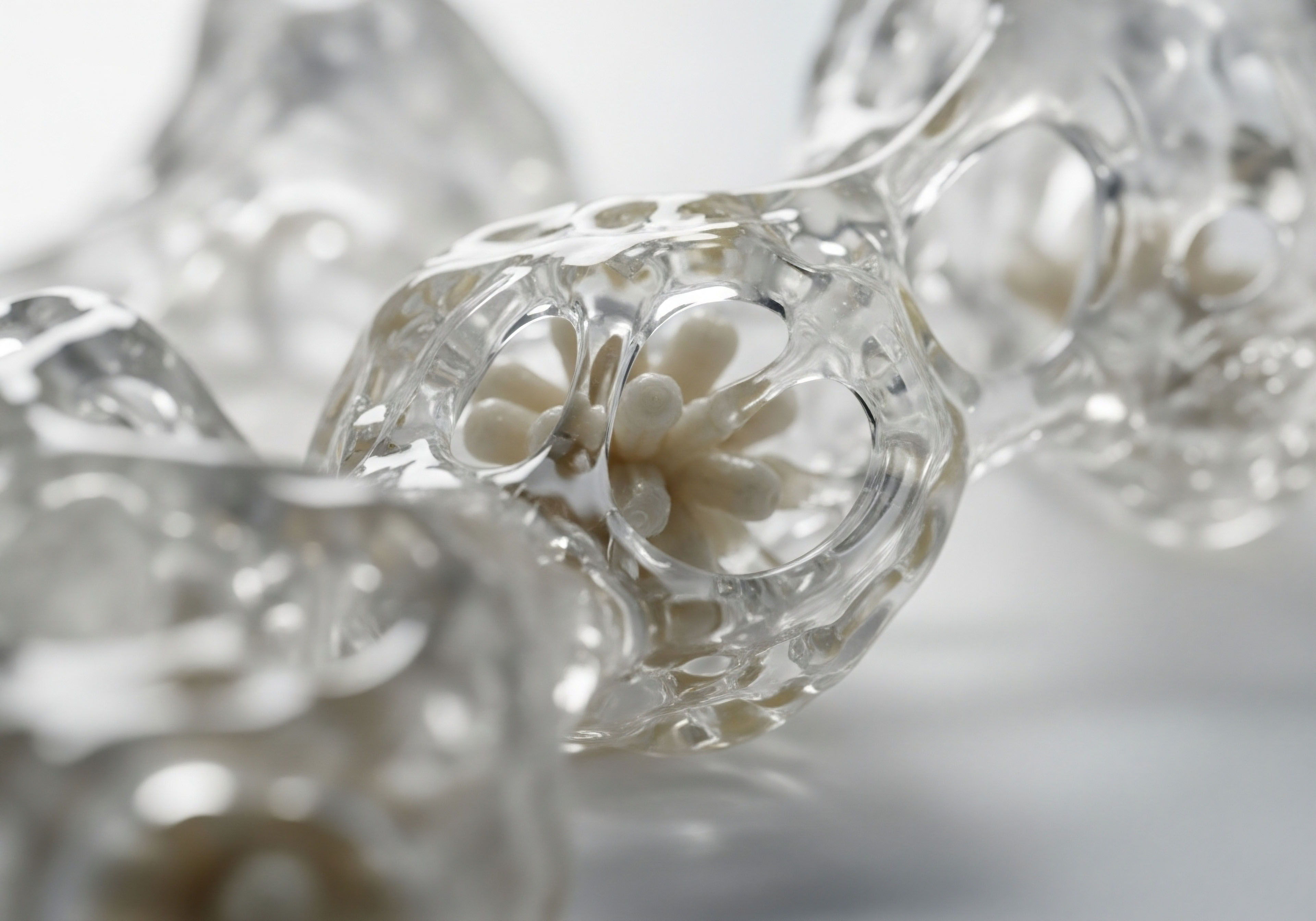

Fundamentals
The experience of watching more hair collect in your brush or seeing a wider part in the mirror is a deeply personal one. It often brings a sense of unease, a feeling that a part of your vitality is diminishing. This is a completely valid and human response to a biological process that can feel both confusing and uncontrollable.
Your journey toward understanding this change begins here, by looking at the intricate systems that govern your body’s functions. We are moving the conversation away from simply covering up symptoms and toward a comprehensive understanding of the biological orchestra playing out within your cells.
The goal is to provide you with the knowledge to see your body as a system you can work with, a biological code you can learn to read and influence. This process is about reclaiming a sense of agency over your own health, starting with the very building blocks of life.
At the heart of hair health is the hair growth cycle, a continuous, three-phase process that every single follicle on your scalp undergoes independently. Think of it as the lifecycle of a single hair strand. Understanding this rhythm is the first step to comprehending how interventions, like peptide therapies, can effectively alter the outcome.
Each phase has a distinct purpose and duration, and the balance between them determines the density and health of your hair. When this delicate rhythm is disturbed, whether by hormonal shifts, nutritional deficiencies, or age-related changes, the visible result is thinning hair or loss. Our focus is on how to support and restore the optimal function of this cycle.
The hair growth cycle is a dynamic, multi-phase process that dictates the life and death of every hair strand on your scalp.

The Anagen Phase the Period of Active Growth
The anagen phase is the active growth stage for hair follicles. During this period, the cells in the dermal papilla, located at the base of the follicle, divide rapidly to form the new hair shaft. This is a period of intense metabolic activity, requiring significant energy and a rich supply of nutrients delivered by the scalp’s micro-vasculature.
The hair grows continuously, pushing the previous hair, which has detached from the follicle, up and out. For the hair on your scalp, this phase can last anywhere from two to seven years. The length of the anagen phase is genetically determined, which is why some individuals can grow their hair to great lengths while others cannot.
A longer anagen phase means thicker, fuller hair because more follicles are in the growth stage at any given time. Any effective hair restoration strategy must focus on prolonging this vital phase, ensuring that follicles remain productive for as long as possible. This is where the biological signaling we will discuss becomes so important.

The Cellular Machinery of Anagen
Within each follicle, a complex interplay of growth factors and signaling molecules orchestrates the anagen phase. Keratinocyte Growth Factor (KGF) and Vascular Endothelial Growth Factor (VEGF) are two of the primary proteins that sustain this process.
VEGF is instrumental in angiogenesis, the formation of new blood vessels, which ensures the metabolically active follicle receives the oxygen and nutrients it needs to build a strong hair fiber. KGF, on the other hand, directly stimulates the proliferation of keratinocytes, the cells that produce keratin, the structural protein that makes up over 90% of a hair strand.
The integrity of this cellular machinery is paramount. When the signals are strong and the nutrient supply is robust, the resulting hair is thick and well-pigmented. When the system is compromised, the anagen phase shortens, and the hair produced becomes progressively weaker and thinner.

The Catagen and Telogen Phases Transition and Rest
Following the active growth period, the follicle transitions into the catagen phase. This is a short, transitional stage that lasts only about two to three weeks. During this time, the hair follicle shrinks, and the hair shaft is cut off from its blood supply, detaching from the dermal papilla.
This marks the end of active growth. The follicle becomes a fraction of its original size, and the hair is now known as a club hair. This process is a necessary and normal part of the cycle, allowing the follicle to reset and prepare for the next growth phase. It is a controlled, apoptotic process, a programmed cell death that is essential for tissue renewal.
The final phase is the telogen, or resting, phase. The club hair rests in the follicle for about three to four months while the follicle itself remains dormant. At any given time, about 10-15% of the hairs on your scalp are in the telogen phase.
At the end of this period, the follicle re-enters the anagen phase, and a new hair begins to form, pushing the old club hair out. This is the hair you see shedding on a daily basis. Shedding 50 to 100 hairs per day is a normal part of a healthy hair cycle.
Hair loss becomes a concern when the shedding rate increases significantly or when the new hair that grows back is finer and weaker than before, a process known as miniaturization. This indicates a disruption in the cycle, often characterized by a shortened anagen phase and a prolonged telogen phase.

What Are Peptides and How Do They Fit In?
Peptides are short chains of amino acids, which are the fundamental building blocks of proteins. You can think of them as small, highly specific biological messengers. Proteins are long, complex chains of hundreds or thousands of amino acids, while peptides are much shorter, typically containing 50 or fewer.
Their small size allows them to be easily absorbed and utilized by the body. Within our physiology, peptides act as signaling molecules, instructing cells to perform specific functions. They might tell a skin cell to produce more collagen, a muscle cell to repair itself, or, in the context of hair, a follicle to enter or remain in the anagen growth phase.
Peptide therapy for hair growth utilizes these precise signaling capabilities to directly influence the follicular environment, encouraging a return to a more youthful and robust growth cycle. They are not a blunt instrument; they are a targeted communication tool that speaks the body’s own language.


Intermediate
Advancing from a foundational knowledge of the hair cycle, we can now examine the specific tools used to modulate this process. Peptide therapies represent a sophisticated approach to hair restoration, moving beyond generalized treatments to target the precise biological pathways that govern follicular health. This is where the science becomes actionable.
The application of specific peptides is designed to address the root causes of hair thinning at a cellular level, such as poor scalp circulation, inflammation, and the shortening of the anagen phase. Each peptide has a unique mechanism of action, a specific message it delivers to the cells within the scalp’s microenvironment. Understanding these mechanisms allows for a more tailored and effective protocol, aligning the therapeutic tool with the individual’s specific physiological needs.
Specific peptides act as targeted biological signals to rejuvenate the scalp environment and correct disruptions in the natural hair growth cycle.

Copper Peptides (GHK-Cu) the Scalp Rejuvenator
Among the most studied and utilized peptides for hair restoration is GHK-Cu, a copper peptide complex naturally found in human plasma. Its levels decline with age, which correlates with a decreased capacity for tissue repair. GHK-Cu is a powerful regenerative molecule with a tripartite action on the scalp.
First, it has potent anti-inflammatory properties, which are critical because chronic micro-inflammation at the follicular level is a known contributor to hair loss in conditions like androgenetic alopecia. By calming this inflammation, GHK-Cu helps to create a more favorable environment for hair growth.
Second, GHK-Cu is a key modulator of tissue remodeling. It stimulates the synthesis of collagen and elastin, essential proteins that provide structural integrity to the skin and anchor the hair follicles firmly in the dermis. A stronger extracellular matrix means better hair anchoring and reduced shedding.
Third, and perhaps most importantly, GHK-Cu promotes angiogenesis, the formation of new blood vessels. By enhancing blood flow to the scalp, it ensures that hair follicles receive a richer supply of the oxygen and nutrients required for the intense metabolic demands of the anagen phase. Clinical data has shown that topical application of GHK-Cu can increase hair density and thickness by enlarging miniaturized vellus follicles back into healthy terminal follicles.

How Does GHK-Cu Compare to Traditional Treatments?
Traditional treatments like minoxidil and finasteride have been the standard of care for decades. Minoxidil is a vasodilator, meaning it works primarily by widening blood vessels to improve blood flow. Finasteride is a 5-alpha-reductase inhibitor, blocking the conversion of testosterone to dihydrotestosterone (DHT), the hormone responsible for follicular miniaturization in androgenetic alopecia. While effective for many, these treatments have limitations. Minoxidil’s effect is often temporary and can cause scalp irritation, while finasteride can be associated with systemic side effects.
GHK-Cu offers a multi-faceted mechanism that complements and, in some cases, provides an alternative to these approaches. It improves circulation like minoxidil but also rebuilds the scalp’s structural matrix and reduces inflammation. Some research suggests GHK-Cu may also help modulate DHT levels at the scalp. This comprehensive action addresses multiple facets of hair loss simultaneously. The table below outlines a comparison of these mechanisms.
| Therapeutic Agent | Primary Mechanism of Action | Secondary Effects | Primary Application |
|---|---|---|---|
| Minoxidil | Vasodilation (widening of blood vessels) | May increase potassium channel opening in cells | Topical treatment for androgenetic alopecia |
| Finasteride | Inhibition of 5-alpha-reductase enzyme | Systemic reduction of DHT levels | Oral treatment for male pattern baldness |
| GHK-Cu Peptide | Promotes angiogenesis and tissue remodeling | Anti-inflammatory, stimulates collagen production | Topical treatment for general hair thinning and scalp health |

Biomimetic Peptides Engineering the Growth Phase
Biomimetic peptides are synthetic compounds engineered to mimic the body’s own natural peptides. In the context of hair growth, these are often designed to replicate the function of specific growth factors that regulate the hair cycle.
For instance, certain biomimetic peptides can simulate the activity of Fibroblast Growth Factor (FGF) or Keratinocyte Growth Factor (KGF), directly signaling the follicular stem cells to remain in or re-enter the anagen phase. By effectively “tricking” the follicle into behaving as if it were receiving a stronger natural growth signal, these peptides can help to extend the duration of the anagen phase.
This leads to longer, thicker hair strands and a visible increase in hair density over time, as fewer follicles are entering the resting telogen phase. They are particularly effective in cases of telogen effluvium, a condition characterized by excessive shedding due to a premature shift of follicles into the telogen phase, often triggered by stress, illness, or hormonal changes.
- Acetyl Tetrapeptide-3 This peptide is often combined with red clover extract. It works by stimulating the proteins of the dermal-epidermal junction, improving the anchoring of the hair fiber into the follicle. Better anchoring reduces hair shedding.
- Palmitoyl Tetrapeptide-7 This peptide is known for its anti-inflammatory effects. It helps to reduce the interleukin-6 (IL-6) production, a signaling molecule that promotes inflammation. Reducing inflammation in the scalp can prevent damage to the hair follicles.
- Capixyl™ This is a popular proprietary complex that combines a biomimetic peptide (Acetyl Tetrapeptide-3) with a red clover extract. It is designed to prevent and stop the hair loss process, stimulate hair growth, and reduce inflammation in the scalp.

Growth Hormone Releasing Peptides a Systemic Approach
While peptides like GHK-Cu are typically applied topically for a localized effect, another class of peptides works systemically to influence growth throughout the body. These are the Growth Hormone Releasing Peptides (GHRPs) and Growth Hormone Releasing Hormones (GHRHs) like Sermorelin and Ipamorelin.
These peptides are administered via subcutaneous injection and work by stimulating the pituitary gland to produce and release more of the body’s own natural growth hormone (GH). Growth hormone is a master hormone that plays a key role in cellular regeneration and repair throughout the body.
While not a direct hair loss treatment, optimizing GH levels can have a significant indirect benefit on hair health. Healthy GH levels support the overall vitality of all tissues, including the skin and hair follicles. This systemic approach can be particularly beneficial for individuals whose hair thinning is part of a broader picture of age-related hormonal decline. It addresses the foundational health of the body, which in turn supports the health of the hair.


Academic
An academic exploration of peptide therapy’s influence on hair growth requires a deep dive into the molecular signaling pathways that govern follicular cycling. The clinical phenomena of hair growth, rest, and shedding are surface-level manifestations of an exquisitely complex and dynamic interplay of genetic expression, cellular communication, and tissue homeostasis.
The transition from a healthy, long anagen phase to the miniaturized follicles characteristic of androgenetic alopecia is fundamentally a story of pathological signaling. Our focus here will be on one of the most critical regulatory networks in hair follicle biology ∞ the Wnt/β-catenin signaling pathway. Understanding this pathway is essential to comprehending the sophisticated mechanisms through which certain peptides exert their therapeutic effects.

The Wnt/β-Catenin Pathway a Master Regulator of Follicular Fate
The Wnt/β-catenin pathway is a highly conserved signaling cascade that plays a central role in embryonic development and adult tissue maintenance. In the context of skin biology, it is the master regulator of hair follicle induction, development, and regeneration.
The initiation of a new anagen phase, a process known as follicular neogenesis in the embryo and regeneration in the adult, is critically dependent on the activation of this pathway. The process begins when Wnt ligands, a family of secreted signaling proteins, bind to Frizzled (Fz) receptors and their co-receptors, LRP5/6, on the surface of dermal papilla cells and follicular stem cells.
This binding event triggers a cascade of intracellular events that culminates in the stabilization and nuclear translocation of the protein β-catenin.
Under normal, quiescent conditions, β-catenin is constantly being phosphorylated by a “destruction complex” (composed of Axin, APC, GSK-3β, and CK1α) and subsequently targeted for proteasomal degradation. The binding of Wnt prevents this degradation.
The stabilized β-catenin then accumulates in the cytoplasm and enters the nucleus, where it partners with transcription factors of the TCF/LEF family to activate the expression of a suite of target genes. These genes encode proteins that drive cell proliferation, differentiation, and the morphogenetic processes required to build a new hair follicle and shaft.
Research has demonstrated that a robust activation of the Wnt/β-catenin pathway is the definitive molecular switch that pushes a telogen follicle into a new anagen phase.
The Wnt/β-catenin signaling cascade is the primary molecular engine driving the transition of a resting hair follicle into the active growth phase.

How Does Androgenetic Alopecia Disrupt This Pathway?
In androgenetic alopecia, the hormone dihydrotestosterone (DHT) binds to androgen receptors in susceptible dermal papilla cells. This binding event initiates a downstream signaling cascade that actively suppresses the Wnt/β-catenin pathway. DHT upregulates the expression of certain Wnt pathway inhibitors, such as Dickkopf-1 (DKK1).
DKK1 is a secreted protein that binds to the LRP6 co-receptor, preventing the formation of the active Wnt-Fz-LRP6 complex. This effectively shuts down the Wnt signal. The result is that the β-catenin destruction complex remains active, β-catenin levels in the nucleus plummet, and the pro-growth target genes are not transcribed.
This leads to a progressive shortening of the anagen phase and a lengthening of the telogen phase. The follicle fails to receive the necessary signals to maintain robust growth, leading to the characteristic miniaturization where large, terminal follicles are gradually replaced by small, vellus ones.

What Is the Molecular Mechanism of Peptide Intervention?
The therapeutic potential of certain peptides lies in their ability to positively modulate this compromised Wnt/β-catenin pathway. They can act at various points in the cascade to counteract the inhibitory effects of DHT and promote a pro-growth signaling environment.
Copper peptide GHK-Cu, for instance, has been shown in vitro to increase the expression of integrins and other cell adhesion molecules that facilitate the communication between the dermal papilla and the epithelial stem cells. This enhanced cell-to-cell communication is thought to amplify pro-growth signals, including the Wnt pathway.
Furthermore, some studies suggest that GHK-Cu can influence gene expression in a way that favors anagen maintenance. One proposed mechanism is its ability to upregulate the expression of certain growth factors that can, in turn, activate signaling pathways that cross-talk with the Wnt cascade.
For example, by stimulating Vascular Endothelial Growth Factor (VEGF), GHK-Cu not only improves blood supply but also activates the PI3K/Akt pathway, which can inhibit GSK-3β, a key component of the β-catenin destruction complex. By inhibiting the inhibitor, this cross-talk mechanism leads to higher levels of stabilized β-catenin, effectively mimicking a Wnt signal. The table below details some of the molecular targets within this pathway.
| Component of Pathway | Function in Healthy Follicle | Effect of DHT in Androgenetic Alopecia | Potential Point of Peptide Intervention |
|---|---|---|---|
| Wnt Ligands | Initiate the signaling cascade | Expression may be reduced | Some peptides may stimulate Wnt production from surrounding cells |
| DKK1 (Inhibitor) | Low levels, allowing Wnt signaling | Upregulated, blocking the LRP6 co-receptor | Therapies could aim to inhibit DKK1 activity |
| β-catenin | Accumulates and moves to the nucleus | Continuously degraded, low nuclear levels | Peptides can indirectly stabilize β-catenin via cross-talk pathways (e.g. inhibiting GSK-3β) |
| TCF/LEF Transcription Factors | Activate anagen-promoting genes | Remain inactive due to lack of β-catenin | Intervention focuses on providing the necessary β-catenin co-activator |
This academic perspective reframes peptide therapy from a simple “hair growth treatment” to a sophisticated form of molecular medicine. The goal is to restore the integrity of a fundamental biological signaling pathway that has been pathologically disrupted. The success of these therapies is a testament to the power of targeting the precise molecular lesions that underlie a clinical condition.
Future research will likely focus on developing even more specific peptides that can directly activate the Wnt pathway or inhibit its antagonists with greater precision, offering a highly targeted and effective strategy for reversing the course of androgenetic alopecia.
- Future Research Directions The development of synthetic peptides that are direct agonists for the Frizzled receptor could provide a powerful therapeutic tool.
- Delivery Systems Enhancing the topical delivery of these peptides to the dermal papilla is a key area of research. Microneedling and other transdermal technologies are being explored to increase bioavailability.
- Combination Therapies Combining Wnt-pathway-activating peptides with other treatments, such as 5-alpha-reductase inhibitors, could offer a synergistic effect by tackling the problem from multiple angles.

References
- Uno, H. and S. B. Kurata. “Chemical agents and peptides affect hair growth.” Journal of Investigative Dermatology, vol. 101, no. 1, 1993, pp. 143S-147S.
- Fink, J. G. et al. “Peptide Regulation of Gene Expression ∞ A Systematic Review.” Molecules, vol. 26, no. 22, 2021, p. 7053.
- Gentile, Pietro, and Simone Garcovich. “The Effect of Platelet-Rich Plasma (PRP) in Hair Regrowth ∞ A Review.” Journal of Cutaneous and Aesthetic Surgery, vol. 13, no. 3, 2020, pp. 182-192.
- Pickart, Loren, and Anna Margolina. “Regenerative and Protective Actions of the GHK-Cu Peptide in the Light of the New Gene Data.” International Journal of Molecular Sciences, vol. 19, no. 7, 2018, p. 1987.
- Choi, F-D. et al. “The effect of tripeptide-copper complex on human hair growth in vitro.” Archives of Pharmacal Research, vol. 30, no. 7, 2007, pp. 834-839.
- Pyo, H.K. et al. “The Effect of Tripeptide-Copper Complex on Human Hair Growth in Vitro.” Archives of Pharmacal Research, vol. 30, no. 7, 2007, pp. 834-839.
- Lee, Sang-Yeol, et al. “A new biomimetic peptide, CG-Nokkin, improves hair growth by modulating the expression of Wnt/β-catenin and BMP/Smad signaling pathways.” International Journal of Cosmetic Science, vol. 38, no. 4, 2016, pp. 333-340.
- van der Woude, J. D. and C. L. M. van der Vleuten. “Minoxidil ∞ a review of its use in the treatment of male androgenetic alopecia.” Journal of the European Academy of Dermatology and Venereology, vol. 15, no. 6, 2001, pp. 590-592.

Reflection
You have now journeyed from the visible experience of hair thinning to the invisible, intricate world of cellular signaling that controls it. This knowledge is more than just information; it is the foundation for a new perspective on your own biology. The processes occurring in your hair follicles are not isolated events.
They are deeply connected to the broader systems of your endocrine health, your metabolic function, and your body’s overall state of vitality. Seeing your body through this lens, as a network of interconnected systems, is the first and most meaningful step toward proactive wellness.
Your health journey is uniquely yours, and the path forward involves understanding your individual biological narrative. This understanding empowers you to ask more precise questions and seek solutions that are truly aligned with your body’s specific needs. The potential for recalibration and renewal begins with this deeper awareness.



